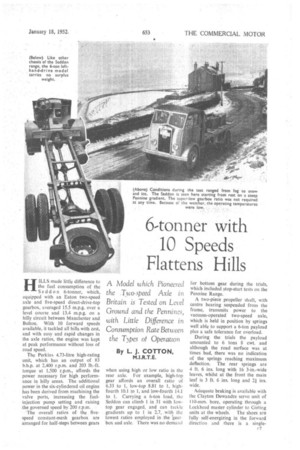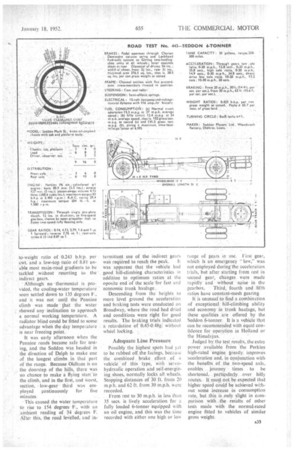6-tonner with
Page 45

Page 46

Page 51

If you've noticed an error in this article please click here to report it so we can fix it.
10 Speeds Flattens Hills A Model which Pioneered the .Two-speed Axle in Britain is Tested on Level Ground and the Pennin2s, with Little Difference in Consumption Rate Between the Types of Operation By L. J. COTTON, M.I.R.T.E. HILLS made little difference to the fuel consumption of the Seddon 6-tonner, which, equipped with an Eaton two-speed axle and five-speed direct-drive-top gearbox, averaged 15.5 m.p.g. over a level course and 13.4 m.p.g. on a hilly circuit between Manchester and Bolton. With 10 forward speeds available, it tackled all hills with zest, and with easy and rapid changes in the axle ratios, the engine was kept at peak performance without loss of road speed.
The Perkins 4.73-litre high-rating unit, which has an output of 83 b.h.p. at 2,400 r.p.m. and 203 lb.-ft. torque at 1,500 r.p.m., affords the power necessary for high performance in hilly areas. The additional power in the six-cvlindered oil engine has been derived from machining the valve ports, increasing the fuelinjection pump setting and raising the governed speed by 200 r.p.m.
The overall ratios of the . fivespeed constant-mesh gearbox are arranged for half-steps between gears
when using high or low ratio in the rear axle. For example, high-top gear affords an overall ratio of 6.33 to 1, low-top 8.81 to 1, highfourth 10.1 to 1, and low-fourth 14.1 to 1. Carrying a 6-ton load, the Seddon can climb I in 31 with lowtop gear engaged, and can tackla gradients up to 1 in 2,7, with the lowest ratios employed in the 'gear box and axle. There was no demand
for bottom gear during the trials, which included stop-start tests on the Pennine Range.
A two-piece propeller shaft, with centre bearing suspended from the frame, transmits power to the vacuum-operated two-speed axle, which is held in position by springs well able to support a 6-ton payload plus a safe tolerance for overload, During the trials the payload amounted to 6 tons 8 cwt. and although the road surface was at times bad, there was no indication of the springs reaching maximum deflection. The rear springs are 4 ft. 6 ins, long with 16 3-in.-wide leaves, whilst at the front the main leaf is 3 ft, 6 ins, long and 2. ins. wide.
Adequate braking is available with the Clayton Dewandre servo unit of 110-mm. bore, operating through a Lockheed master cylinder to Girling units at the wheels. The shoes are fully self-energizing in the forward direction and there is a singlec7 leading-shoe action in reverse. On home models the servo and master cylinder are carried outside the offside frame member, but the overseas version has the servo, master cylinder and vacuum reservoir fitted within the frame.
Although the vehicle has full forward control, the engine cover is shallower than on contemporary chassis, because the power unit is mounted fairly low. Nevertheless, the injectors and fuel-injection pump are reasonably accessible.
In general, the vehicle has all the qualities necessary for economic operation and is designed for accessibility. It has no unnecessary frills which might add to its weight or cost. With standard tyres and a platform body, it just qualifies for the 30 m.p.h. speed limit. The 1-in.thick frame which is now employed has increased the former. unladen weight. The vehicle supplied for c8 test had 36 by 8-in. tyres and a heavier platform body, which raised the unladen weight to 3 tons 4 cwt.
In Britain such a vehicle would be restricted to 20 m.p.h. maximum speed, at which rate the engine would be turning at a mere 1,100 r.p.m. with the highest gear engaged. Obviously, drivers will be tempted to exceed the legal speed and in overseas countries its normal pace will be 40 m.p.h. or more. Therefore, I
had no qualms in testing the vehicle at speeds normal in overseas operation.
After starting the trials on icecovered roads -in Oldham, the conditions varied from fog at Manchester and Bolton to snow on the hills towards the north. The average day temperature ranged from 31 to 34 degrees F.
The vehicle was nearing completion when I arrived at the factory and after loading and fitting the fuel tank in She cab, it was ready for test. I decided to run the consumption trials first, with the possibility of the weather improving later in the day for the short performance test, The roads over the Pennines were impassable at the time.
Within two miles of Oldham there is the fairly level Broadway leading to Manchester, and this was selected as ground suitable to represent conditions in Belgium or Holland Further, to reproduce Continental operation, a maximum speed of 35-38 m.p.h was set, but several delays caused by traffic made heavy inroads into the schedule, and after deducting standing time at traffic lights, the average running speed worked out to 26 m.p.h. for the outward run On the return leg from Manchester, there were
fewer stops, but indirect gears were required on two gradients. Even s6. the average speed worked out to 28 m.p.h.
Remembering that the chassis was new and that the average speed was high the fuel return of 15.5 m.p.g was at least average for its class when developed to the time-loadmileage factor.
The road from Manchester to Bolton is known to goods-vehicle drivers for its gradients, and icy conditions during the test enforced full use of the gearbox in climbing and descending. The long 1-in-10 climb from Pendlebury required low-third gear for a period, but as soon as the grade slackened, the higher ratio was engaged in the axle without loss of road speed.
During an out-and-return run between the two towns, .fourth and third gears were required for 28 per. cent of the .total running time but the average consumption rate worked out to 13.4 m.p.g. A power. to-weight ratio of 0.243 b.h'.p. per cwt. and a low-top ratio of 8.81enable most main-road gradients to be tackled , without resorting to the indirect gears.
Although no thermostat is provided, the cooling-Water temperature soon settled down to 135 degrees F., and it was not until thePennine climb was made that the water showed any inclination to approach a normal working temperature. A radiator blind could be fitted to some advantage when the day temperature is near freezing point.
It was early afternoon when the Pennine roads became safe for testing, and the Seddon was headed in the direction of Delph to make one
. the longest climbs, in that part of the range. Because Oldham is on the doorstep of the hills, there was no chance to make a flying start'to the climb, and in the first, and Worst, section, low-gear third was employed pontinuously for 'five minutes.
This caused the water temperature to rise to 154 degrees-F., with an -airibient reading of 34 degrees F. After this, the road levelled, and' in
termittent use of the indirect gears was required to reach the peak. It was apparent that the vehicle had good hill-climbing characteristics in addition to optimum ratios at the oposite end of the scale for fast and economic trunk haulage.
Descending from the heights to more level ground the acceleration and braking tests were conducted on Broadway, where the road had dried and conditions were right for good results. The braking trials indicated a retardation of 0.4540.48& without wheel locking.
Adequate Line Pressure Possibly the .highest spots had ye tube rubbed off,,the facings, because the Combined , brake effort , of a vehicle "of-this • type, With servohydraulic operation and self-energizing, shoes, normally locks allwheels. Stopping distances of 30 ft. from 20 m.p.h. and 62 ft. from 30 m.p.h, were recorded.
. From rest to 30 m.p.h. in less than 35 secs. is lively acceleration for a fully loaded 6-tonner 'equipped with an oil engine, and this was the time recorded with either one high or lo' range of gears in use. First gear, which is an emergency "low," was not employed during:the acceleration trials, but after starting from rest in second gear, changes were made rapidly and without noise in the gearbox. Third, fourth and :fifth ratios have constant-mesh gearing.
It is unusual to find a combination of exceptional hill-climbing ability and economy in trunk haulage, but
these qualities are offered by the Seddon 6-tonner It is a vehicle that can be recommended with equal confidence for operation in Holland or the HimaisiYas.
. Judged by the test results, the extra power, ,available from the Perkins
high-rated -engine greatly. improves
acceleration and, in Conjunction with the -benefits of the :two:speed axle, enables .. jobrney.times . to be shortened, particularly_ -over hilly routes, it must not be-expected that
higher speed could be achieved without some inerease in consumption rate, but this is .only slight ill comparison with . the results of other tests made with the normal-rated engine fitted to vehicles of similar gross weight.




















































































